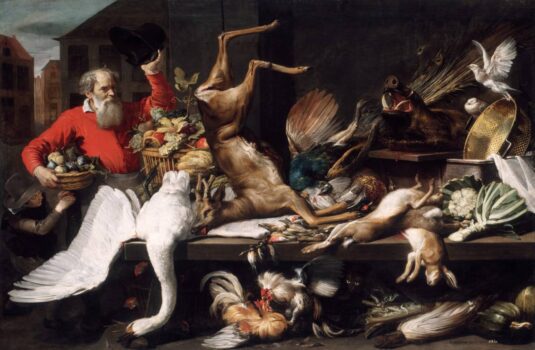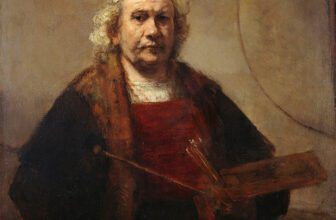Frans Snyders Most Famous Paintings
Frans Snyders (1579 – 1657) play a big place in the golden chapter of Flemish Baroque painting. In an era dominated by towering figures such as Peter Paul Rubens and Anthony van Dyck, Snyders forged a distinct path, one bursting with game, markets, fruit, and animals so vivid they seem to leap from the canvas. His works are not merely decorative feasts; they are encyclopedias of life, movement, and abundance in the 17th century.
This is the story of his art, his fame, his legacy, and the living trail of his works scattered across the world’s greatest museums and collections.
The Story of Frans Snyders
Born in Antwerp in 1579, Snyders grew up in a city at the beating heart of European trade and culture. Antwerp was a bustling mercantile hub, its port brimming with exotic goods from distant continents. Markets overflowed with imported fruit, spices, textiles, and animals. This vibrant environment would shape Snyders’ entire artistic vision.
Snyders apprenticed under Pieter Brueghel the Younger and Hendrick van Balen, both significant painters of the time. While van Balen trained him in refined figure work, Brueghel exposed him to intricate still lifes and bustling scenes. By 1602, Snyders was admitted to the Antwerp Guild of Saint Luke, marking the beginning of his independent career.
A transformative period came in 1608 when he traveled to Italy, like many Northern painters eager to study the Renaissance masters. In Rome, he absorbed the grandeur of classical compositions, the precision of Caravaggio’s realism, and the warmth of Italian color palettes. Yet Snyders resisted becoming an imitator of Italian art, instead, he blended these influences into something distinctly his own.
Upon returning to Antwerp, he formed lifelong friendships and collaborations with Peter Paul Rubens and Jacob Jordaens. Rubens in particular frequently called upon Snyders to paint animals, fruits, and still-life elements in his own large-scale compositions. The partnership elevated Snyders’ visibility, and soon his works graced the walls of aristocratic and royal patrons across Europe.
What Frans Snyders Was Known For
Snyders specialized in still lifes, market scenes, and animal paintings, a genre he elevated to unprecedented scale and complexity.
While many of his contemporaries painted modest tabletop still lifes, Snyders created monumental canvases overflowing with game, vegetables, fruit, and hunting trophies. His animals, lions, deer, dogs, birds, were not static props but fully alive, caught in the midst of movement, interaction, and often struggle.
His artistic trademarks included:
Vivid realism – The fur of a hare, the feathers of a parrot, the glint of fish scales all appear meticulously rendered.
Dynamic compositions – Unlike static still lifes, his paintings often explode with motion, like a boar hunt in full charge.
Collaboration – He often worked with figure painters (Rubens, van Dyck, Cornelis de Vos), supplying the animal and still-life elements.
Abundant symbolism – His markets could be read as allegories of plenty, wealth, and the global reach of Flemish trade.
Frans Snyders Most Famous Paintings
Snyders’ oeuvre is vast, but several works stand out as defining examples of his mastery:
1. Still Life with Dead Game, Fruits, and Vegetables in a Market
This monumental market scene displays Snyders’ unmatched skill in depicting textures and colors. Pheasants, rabbits, and deer hang alongside heaps of grapes, melons, and cabbages. The painting embodies the abundance of Antwerp’s markets.
2. The Fish Market
Here Snyders captures the chaos and variety of a bustling fish market. Crabs crawl across the table, gleaming fish are piled high, and vendors shout to customers. The sea bounty is painted with such precision that art historians still identify species centuries later.
3. The Game Stall
A masterwork of composition, this painting shows wildfowl, hares, and venison in an elaborate arrangement. The dramatic lighting and rich colors give the still life a theatrical presence.
4. Concert of Birds
A whimsical yet deeply studied piece, depicting an array of bird species apparently singing together. It reveals Snyders’ ability to infuse natural history with imaginative flair.
5. Boar Hunt
A violent, gripping scene of dogs and hunters pursuing a wild boar. The energy is almost sculptural, muscles tensed, teeth bared, fur bristling.
The Most Expensive Frans Snyders Painting
Art auction records place Snyders among the sought-after Flemish masters, though his works often sell below the astronomical prices of Rubens. The highest publicly recorded sale for a Frans Snyders work was “Still Life with Fruit, Dead Game, and a Parrot”, which sold for over $3 million USD at Sotheby’s in the early 2000s.
Private sales may have reached higher sums, particularly for collaborative works with Rubens, where Snyders’ contribution of animals or still-life elements boosts historical and market value.
How Many Paintings Did Frans Snyders Create?
Exact counts are difficult because:
He often worked collaboratively, and attributions vary.
Multiple versions and workshop pieces exist.
Some works are lost or undocumented in private collections.
However, art historians estimate between 300 and 500 paintings attributed wholly or in part to Snyders survive today. His workshop likely produced additional copies and variations for the market.
Where to See Frans Snyders’ Paintings
Snyders’ paintings are spread across the globe, housed in major museums and royal collections.
Notable locations include:
The Prado Museum (Madrid, Spain) – Holds several collaborations with Rubens, including hunting scenes and large still lifes.
The Hermitage Museum (St. Petersburg, Russia) – A rich selection of still lifes and market scenes.
The Louvre (Paris, France) – Includes “Game Stall” and market paintings.
The National Gallery (London, UK) – Several Snyders works, often in collaboration with Rubens.
The Royal Collection (UK) – Masterpieces acquired by British monarchs in the 17th and 18th centuries.
The Kunsthistorisches Museum (Vienna, Austria) – Hunting scenes and lush market compositions.
Museo del Prado – Particularly strong in Snyders’ hunting and still-life works.
The Mauritshuis (The Hague, Netherlands) – A selection of still lifes with game and birds.
Private collections worldwide also hold significant works, many rarely on public view.
Frans Snyders’ Legacy
Frans Snyders transformed the still life from a modest tabletop study into a grand, almost theatrical genre. His paintings bridged naturalism and spectacle, satisfying both the scholarly interest in cataloging nature and the Baroque appetite for drama.
His legacy rests on several pillars:
Elevation of Animal Painting – He legitimized animals as serious subjects in fine art, not just decorative details.
Influence on Successors – Later Flemish and Dutch painters, such as Jan Fyt and Paul de Vos, built on his style.
Cross-genre Collaboration – His partnerships with Rubens and van Dyck remain benchmarks for collaborative excellence in art.
Documentation of Global Trade – Through the exotic fruits, rare birds, and imported goods in his works, Snyders inadvertently chronicled Antwerp’s role in the early modern world economy.
Even today, his paintings feel alive, muscular, tangible, and immersive. They remind us that still life can be anything but still.
A Narrative Glimpse into His World
Imagine stepping into an Antwerp market in 1620. The air is thick with the scent of spices, fresh bread, and sea salt from the day’s catch. Traders from Spain, Italy, and England haggle over barrels of figs and wheels of cheese. In the midst of this, a man with sharp eyes and steady hands stands sketching, not the people, but the fish, the rabbits, the melons piled high.
This man is Frans Snyders.
At night in his workshop, he arranges his subjects under controlled light. A hare’s fur catches the warm glow of an oil lamp; the deep red of a pomegranate bleeds into shadow. He paints quickly but with precision, as if each scale of a fish or each wrinkle on a cabbage is a truth worth recording.
Soon his paintings will travel far, to the courts of Madrid, the salons of Paris, the homes of wealthy merchants. Kings will dine beneath them; scholars will marvel at the lifelike accuracy; hunters will nod in recognition of the chase.
Four centuries later, those same canvases still exude the same sensory power. Stand before them in a museum, and you can almost smell the game, hear the rustle of feathers, feel the moment before the hunt’s climax.
Frans Snyders may not be as widely recognized as Rubens in popular imagination, but within art history he is the undisputed master of monumental still life and animal painting. From the markets of Antwerp to royal palaces, his works celebrated abundance, vitality, and the raw beauty of nature.
With hundreds of surviving paintings and an enduring influence on European art, Snyders’ legacy is secure. His animals still leap, his fruits still glisten, and his markets still bustle, centuries after the paint dried. image / artic




